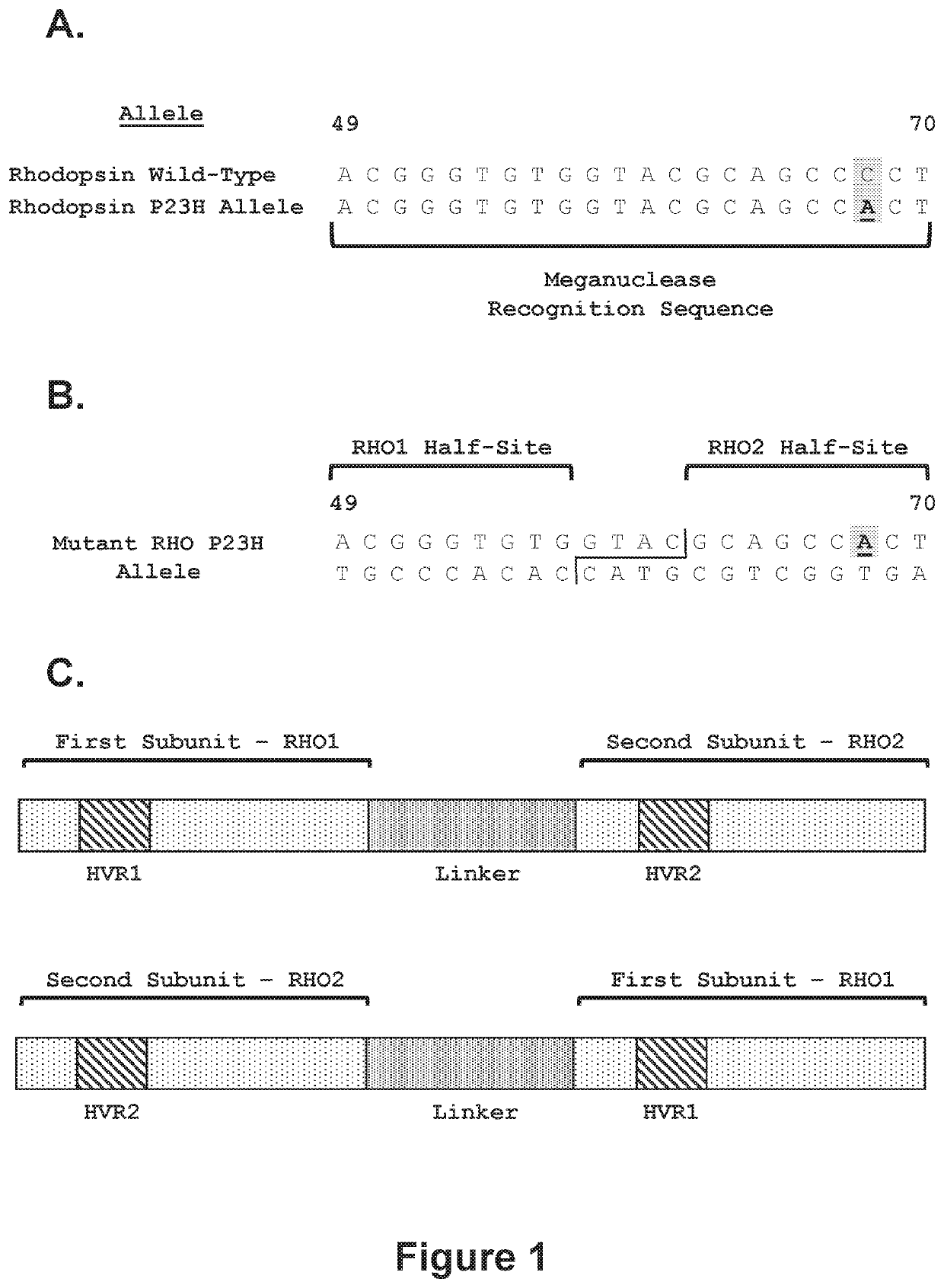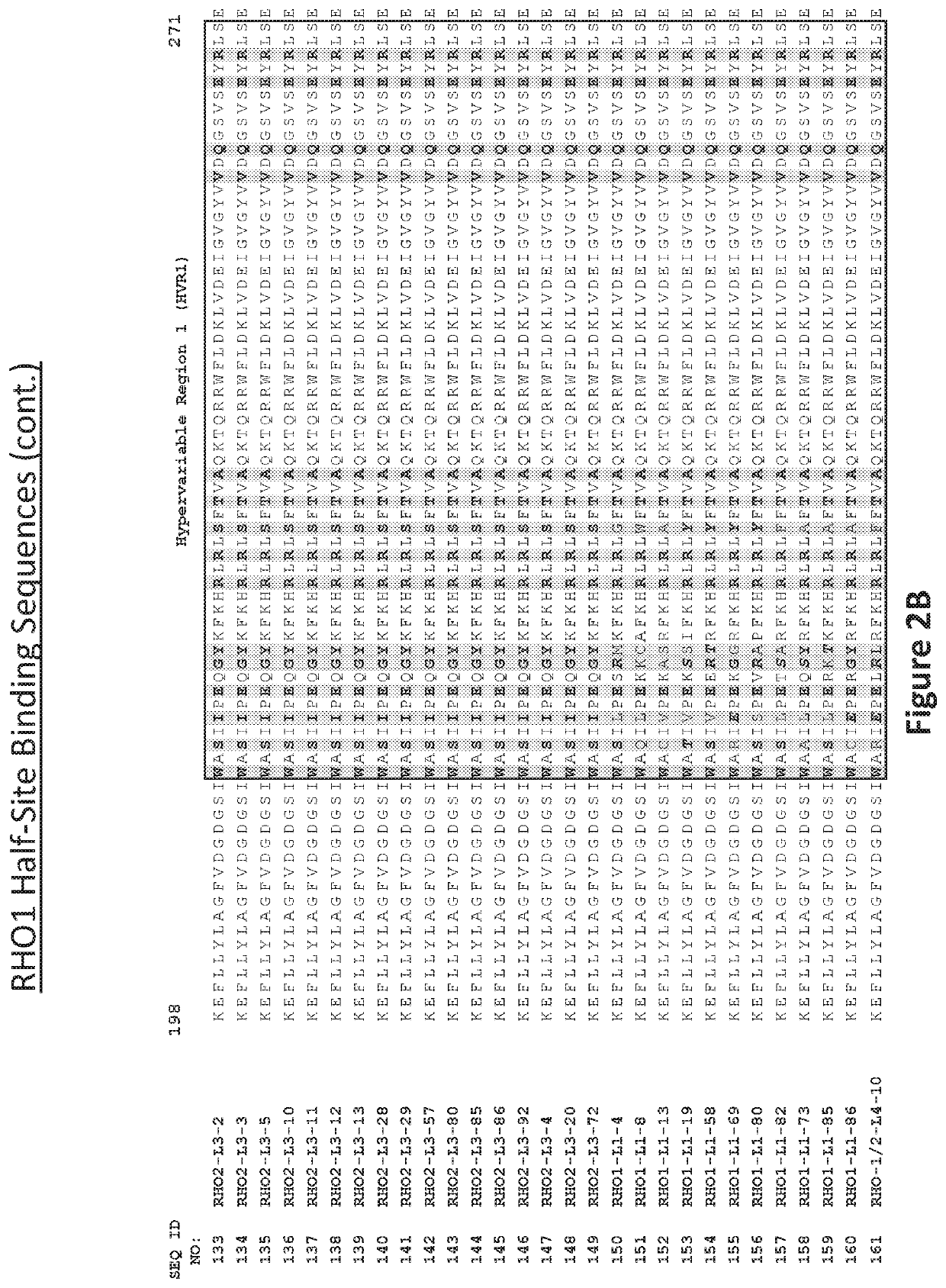Treatment of retinitis pigmentosa using engineered meganucleases
a technology of retinitis pigmentosa and recombinant meganucleases, which is applied in the field of molecular biology and recombinant nucleic acid technology, can solve the problems of delayed dephosphorylation, rp has no effective treatment, and impaired peripheral and dim light vision, so as to delay, prevent, reverse the progression of rp, and disrupt p23h
- Summary
- Abstract
- Description
- Claims
- Application Information
AI Technical Summary
Benefits of technology
Problems solved by technology
Method used
Image
Examples
example 1
Evaluation of Meganucleases that Recognize and Cleave a P23H Recognition Sequence
1. Meganucleases that Recognize and Cleave a P23H Recognition Sequence
[0411]Recombinant meganucleases (SEQ ID NOs:6-93), collectively referred to herein as “RHO 1-2 meganucleases,” were engineered to recognize and cleave one of the P23H recognition sequences (i.e, SEQ ID NO:1), which is present in the mutant RHO P23H allele (see, FIG. 1A). Each RHO 1-2 recombinant meganuclease comprises an N-terminal nuclease-localization signal derived from SV40, a first meganuclease subunit, a linker sequence, and a second meganuclease subunit. A first subunit in each RHO 1-2 meganuclease binds to the RHO1 recognition half-site of SEQ ID NO:1, while a second subunit binds to the RHO2 recognition half-site (see, FIG. 1B).
[0412]As illustrated in FIGS. 2 and 3, RHO1-binding subunits and RHO2-binding subunits each comprise a 56 base pair hypervariable region, referred to as HVR1 and HVR2, respectively. RHO1-binding subuni...
example 2
Specificity of Meganucleases for a P23H Recognition Sequence
1. CHO Reporter Cells Comprising a Corresponding Wild-Type RHO Sequence
[0417]To determine the specificity of RHO 1-2 meganucleases (SEQ ID NOs:6-93) for the P23H recognition sequence of SEQ ID NO:1, a CHO reporter cell line was generated as previously described that comprises the corresponding wild-type RHO recognition sequence (SEQ ID NO:5), referred to herein as the “RHO 3-4 recognition sequence,” and the CHO-23 / 24 recognition sequence. The resulting cells are referred to herein as “RHO 3-4 cells.”
2. Specificity of RHO 1-2 Meganucleases
[0418]RHO 1-2 meganucleases were introduced into RHO 1-2 cells or RHO 3-4 cells to determine if the recombinant meganucleases could discriminate between the P23H recognition sequence of SEQ ID NO:1 and the corresponding wild-type recognition sequence (SEQ ID NO:5). RHO 1-2 meganuclease mRNA was introduced into RHO 1-2 cells or RHO 3-4 cells via electroporation of mRNA as previously describe...
example 3
Generation and Expression of Recombinant AAV Vectors for Expressing Recombinant Meganucleases
1. Recombinant AAV vectors for expressing RHO 1-2 meganucleases
[0420]Recombinant AAV vectors were designed to express RHO 1-2 meganucleases in CHO reporter cells. As shown in FIG. 8A, the recombinant AAV vectors comprise, from 5′ to 3′, a first inverted terminal repeat (ITR), a CMV promoter operably linked to a nucleotide sequence encoding a meganuclease, and a second inverted terminal repeat. In this study, a coding sequence for the RHO-1 / 2-L2-49 meganuclease was incorporated into the recombinant AAV vector.
2. Expression of a RHO 1-2 Meganuclease Following Recombinant AAV Transduction
[0421]A recombinant AAV vector (rAAV-RHO-1 / 2) was prepared for expression of the RHO-1 / 2-L2-49 meganuclease in RHO 1-2 cells using a standard triple-transfection protocol in HEK-293 cells (Drittanti et al. (2001), J Gene Med. 3:59-71). RHO 1-2 CHO reporter cells were transduced with the rAAV-RHO-1 / 2 vector at t...
PUM
 Login to View More
Login to View More Abstract
Description
Claims
Application Information
 Login to View More
Login to View More - R&D
- Intellectual Property
- Life Sciences
- Materials
- Tech Scout
- Unparalleled Data Quality
- Higher Quality Content
- 60% Fewer Hallucinations
Browse by: Latest US Patents, China's latest patents, Technical Efficacy Thesaurus, Application Domain, Technology Topic, Popular Technical Reports.
© 2025 PatSnap. All rights reserved.Legal|Privacy policy|Modern Slavery Act Transparency Statement|Sitemap|About US| Contact US: help@patsnap.com



